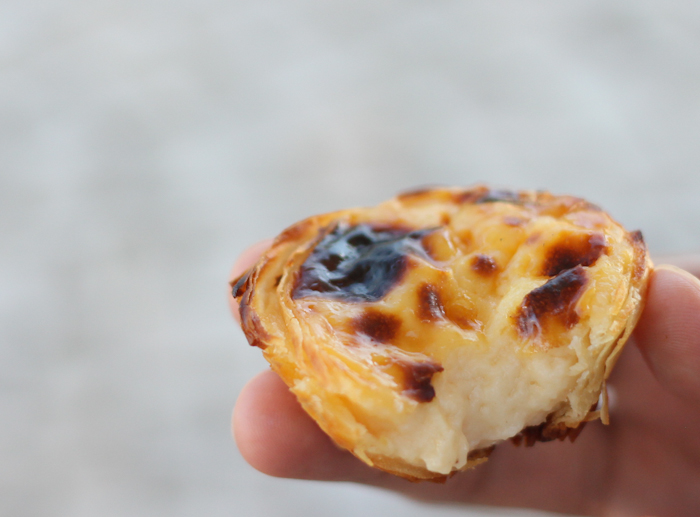
As soon as I completed the Intermediate Cuisine course at Le Cordon Bleu, Arjun and I left Paris for Lisbon. We wanted to spend a week on holiday, something that was overdue considering the city around us had shut down for the summer for the past 6 weeks. I’d wanted to visit Lisbon for a long time. My interest in Lisbon began when I ate my first Pastel de Nata, a Portuguese pastry, at Comme à Lisbonne in Paris, a matchbox sized pastry shop that only makes this one Portuguese treat. Invariably, every time I go there, there’s a fresh batch coming out of the oven and they are served warm with a little bit of powdered cinnamon sprinkled on top. The Pastel (Plural: Pasteis) de Nata is a sweet treat made with golden, flaky puff pastry case that holds a rich, egg yolky (but not overtly so) custard that’s still quite wobbly. Once the pastry is baked, the top forms a glossy skin, blistered in spots. When I first had it, I went back home and looked up several recipes and tried to replicate it, but the more I delved into my research, the more I realised that a good pastel de nata recipe is hard to come by, and is, in fact, a notoriously guarded secret. Instead, I went back to Comme à Lisbonne and happily bought one pastry served on a paper napkin and savoured every little bite while ambling through the Marais.
So, on to Lisbon. Lisbon is such a pretty city. The moorish architecture, the gorgeous hand painted wall tiles, the brick red roofs and the majestic mosaic lined plazas will make you go shutter crazy. Lisbon is the city of seven hills, and this means that there are lots of steep streets to climb – so wear comfy shoes!
A few things about the way I travel: sightseeing doesn’t interest me all that much, unless it’s the kind you do at markets. What’s of prime importance for me that I have my meals for the entire trip planned out. For this I spend hours researching the places to eat at. In addition to my own research, I turned to Salt of Portugal for some excellent, excellent recommendations, as well as Arjun’s Lisbonian classmate.
Getting Around in Lisbon
First, you buy a Viva Viagem card for €0.50 and then top it up with whatever type of ticket you’re interested in. You can buy a €6 ticket that let’s you use the Metro, Bus and Tram for a period of 24 hours. I believe they also have a more cost-effective 5 day pass, that you can find out about when buy a ticket. Fares here.
Where to stay in Lisbon
While the Bairro Alto neighborhood is where all the action is, we wanted to stay a bit further away (near Rossio Metro). The Bairro Alto neighborhood is known to come alive post 11PM and even when the bars shut down, people continue their party on the streets because, in Lisbon, it’s legal to drink on the street! Therefore, not great to get a good night’s sleep if you end up staying at an apartment upstairs from a bar. Plus, this neighborhood has more steep slopes than usual, so we didn’t want to risk ending up with an apartment we’d have to climb to every night after a day of galavanting.
Favourite Spot in Lisbon
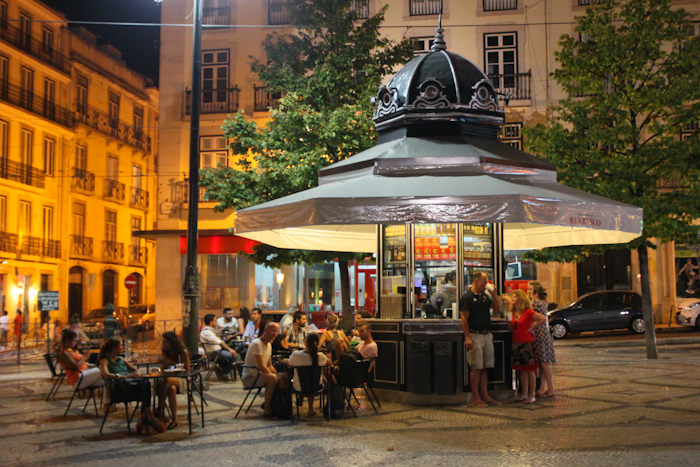
Praça Luíz de Camões – Every evening, we’d invariably end up at this bustling square in the Baixa Chiado neighborhood. We’d buy the local lemongrass (Erva Príncipe) or black currant (Groselha) drink from Quiosque de Refresco (refreshment kiosks) and sip the ice cold drink served in these cool cornstarch glasses, watching the people around us. The kiosque, by the way, is a genius idea that needs to be replicated in other cities.
Favourite Neighbourhood in Lisbon
I think Alfama wins hands down as my favourite neighborhood. It’s typically middle-class and as you walk through the district, you literally get to peek into people’s lifestyle and homes. You can get lost in the lanes and pathways because the tiny streets aren’t even mapped on Google maps. This is also the neighbourhood to catch some live Fado instead of the touristy and not-so-authentic Bairro Alto. We ran into this young fellow who wanted a picture taken.
Touristy Fun
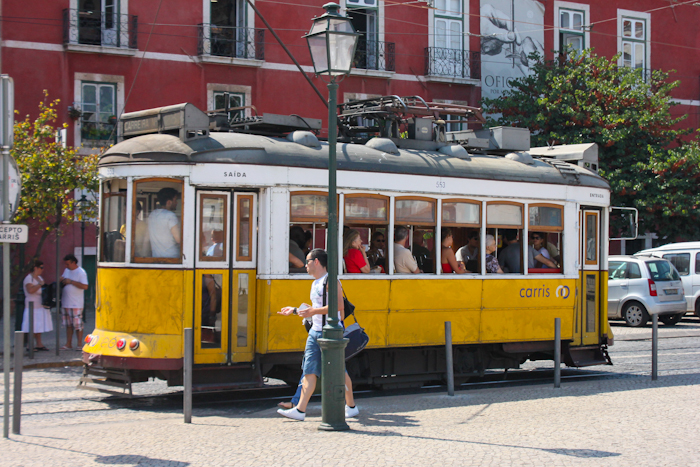
TRAM 28: Ride the Tram 28 in Lisbon that takes you through all the famous tourist spots. But careful! It’s known for its pickpockets as well.
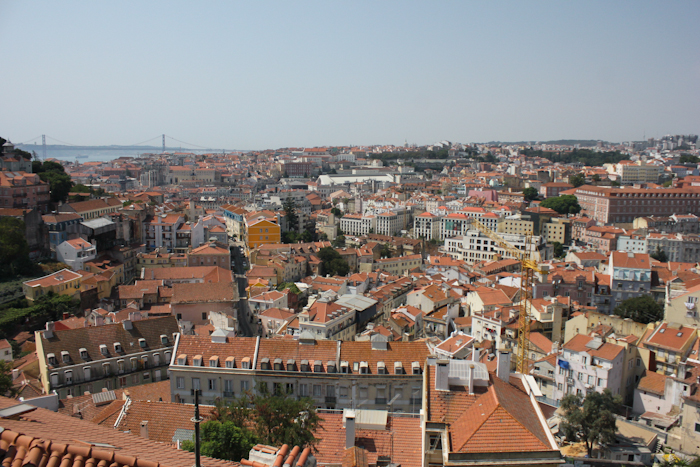
MIRADOURO: The Portuguese love their city views, so when you see a road signed marked “Miradouro” you know you’re not far away from one. Because the city is so hilly, a mere tilt of the head will reveal beautiful views of the city. I loved walking up the stairs from my apartment in the Mouraria (The Moorish Quarter) and perch myself on the steps. Some of my favourite viewing points are: Graça, Jardim de São Pedro de Alcântara – Jardim António Nobre and up from the Santa Justa Lift (using this is also free with the 24 hour transport ticket).
Sweet Things
One thing that was clear on this trip was that the Portuguese have a major sweet tooth. Most pastries here are heavy on cream, egg yolks and sugar. Some were a tad too sweet for my taste (but not the Pasteis de Nata, thanks to their small size). Here are some pastry shops, chocolaterias and gelaterias that we visited and liked.
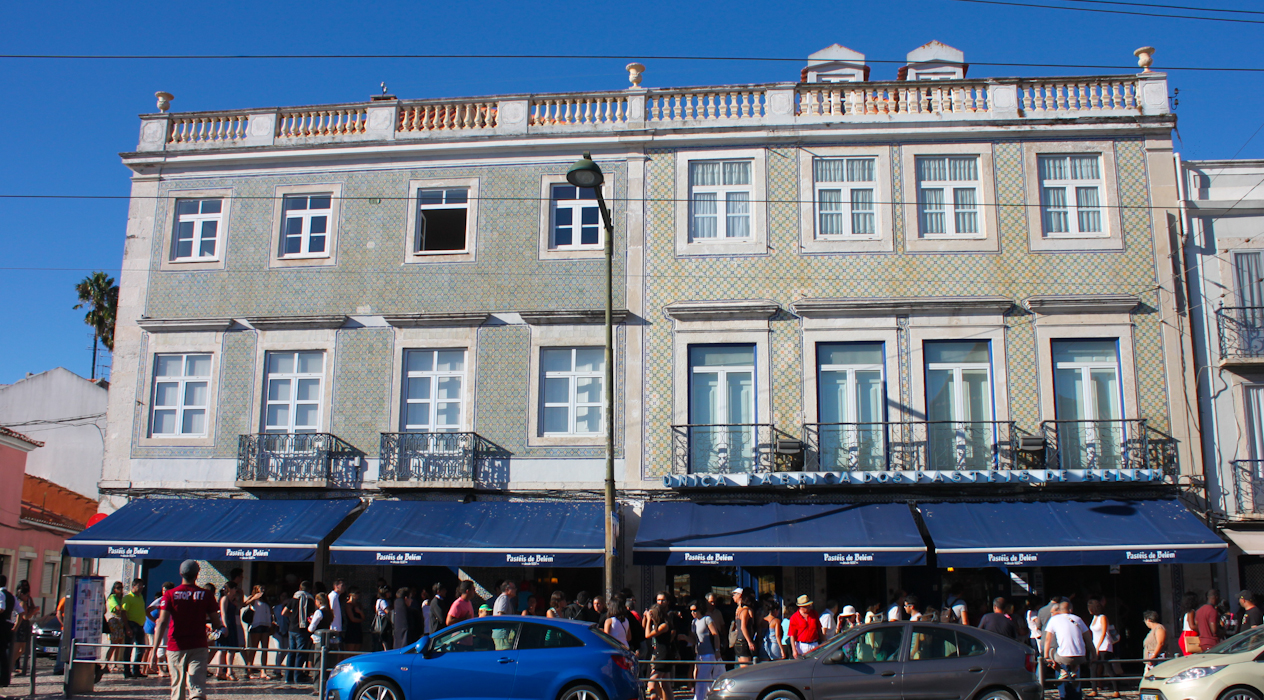
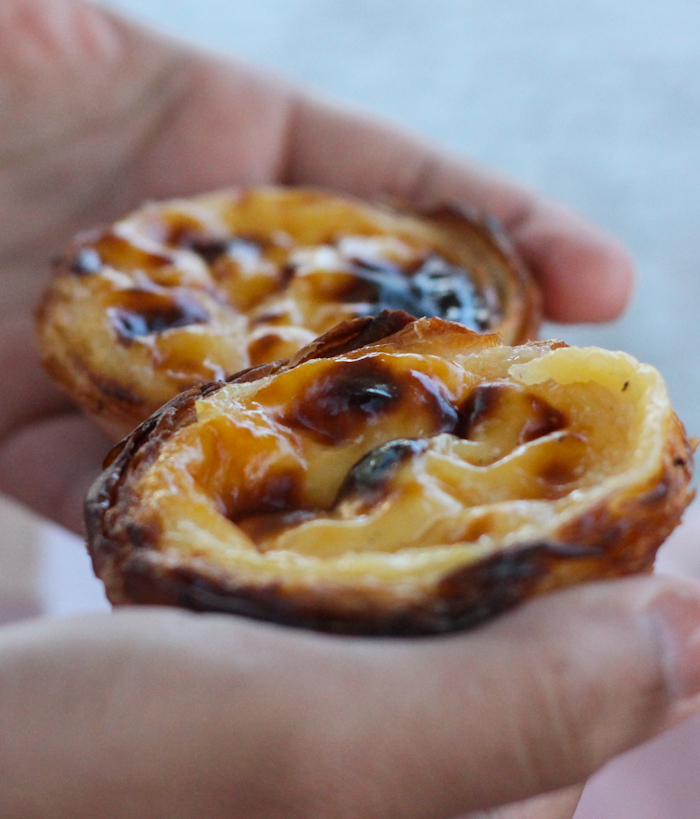
PASTEIS DE BELEM (Rua de Belém, 84-92)
This is the pastry shop for which I made the pilgrimage to Lisbon, and a pilgrimage that was absolutely worthwhile. We ordered a 6-pack of pastries to go and ate them warm at the train station, sprinkled with cinnamon. Watch this.
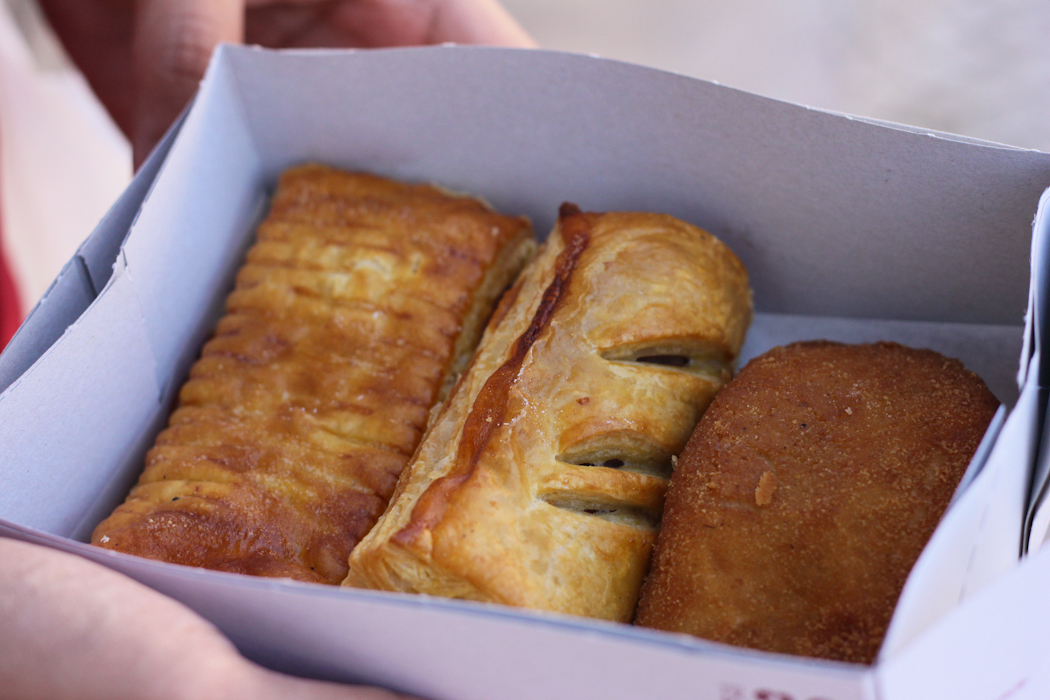
CONFEITARIA NACIONAL (Praça da Figueira, 18B)
This is an old school pastry shop that’s been around since 1829. This one was around the corner from our apartment, so we’d invariably wind up here for breakfast. With no labels on the display shelves, we’d basically point out to the different things to place our order and we’d never know what the filling was, and that was part of the excitement of trying new things.
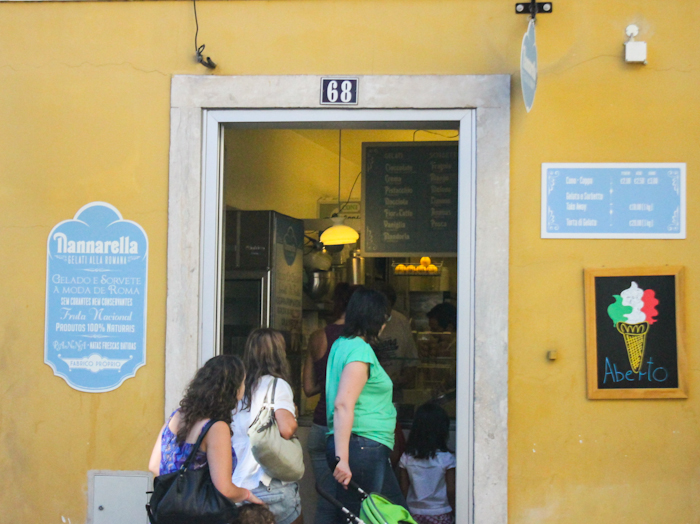
GELATERIA NANNARELLA (Rua Nova da Piedade, 68)
A super tiny gelato shop in the Principe Real neighborhood, that makes some of the best gelato I’ve eaten. Quality ingredients, freshly made gelato, and Italian owners made the gelato at par with what I’ve tried during my Rome Gelato Trail.
SANTINI (Rua do Carmo, 9)
This gelato shop is always packed! So much so that the line for gelato extends to the street and disrupts traffic. They have a huge selection of flavours that changes seasonally.
TARTINE (Rua Serpa Pinto, 15-A)
Portuguese pastries made with the delicate touch of French techniques. We tried their own invention, Chiado (phyllo pastry layered with egg cream) along with Brisa (egg and cream pastry coated with a layer of icing) and Arjun’s favourite: a shortbread tart with a layer of apple compote topped with condensed milk.
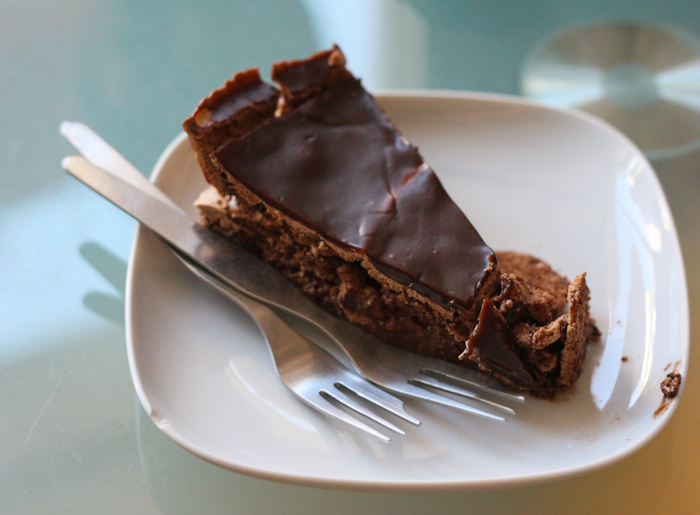
O MELHOR BOLO DE CHOCOLATE DO MUNDO (Rua Coelho da Rocha 99)
The name simply translates to mean “The best chocolate cake in the world” – the recipe is touted to be kept a secret for the past 20 years. Carlos Lopes make his chocolate cake with mousse and ganache sandwiched between layers of meringue. Good, but I’ve got to admit, not quite the best in the world and maybe not worth the trip.
PASTELARIA ALOMA (Rua Francisco Metrass, 67)
This pastelaria has won the prize for the best Pastel de Nata two years in a row. Pastelaria Aloma isn’t in a touristy neighborhood, so you’ll find locals popping in for their coffee and pastry at this modest little patisserie. While there were dozens of pasteis de nata lined along the counter, the waitress went into the kitchen to fetch a warm one for us – such a nice touch.
CLAUDIO CORALLO (Rua Cecílio de Sousa, 85)
Claudio Corallo’s chocolate sorbet is what dreams are made of. Even after my return to Paris, I couldn’t stop thinking about it. Luscious and velvety, the sorbet is made with nothing but pure chocolate, sugar and water. While here, were also treated to a little session on tasting roasted beans.
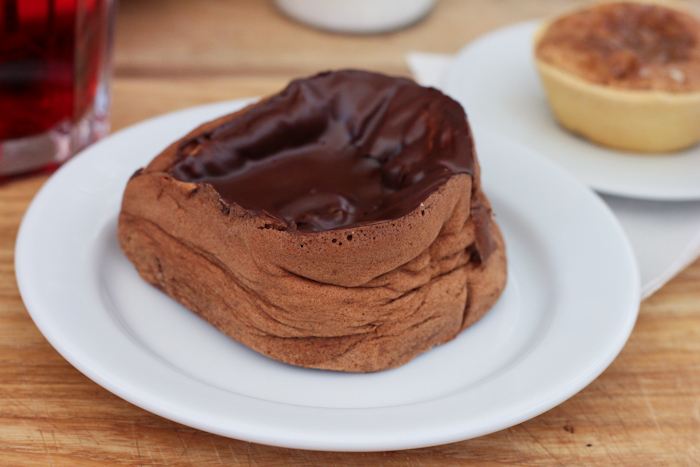
MERCEARIA CRIATIVA (Avenida Guerra Junqueiro 4A)
We popped in here for dessert after eating the steak sandwiches from Cervejaria Ramiro. We sampled a bunch of traditional Portuguese pastries: Cajadas do Piódão (chestnut and honey tarts), Fatia de Bolo (cheesecake) and Pao do Ló (delicate spongy cake, my favourite of the three).
Restaurants in Lisbon
A few points about eating out in Lisbon:
* Almost all restaurants will bring you a plate of olives and bread without you asking for it and add it to the bill in the end. If you don’t want it, you can ask them to take it back or just leave it untouched.
* Sunday is a bad restaurant day. Everything is closed so make sure to plan accordingly. We ended up eating the strangest African food we’ve ever eaten.
* Tipping: It’s not customary, but it’s a good gesture. 5-10% of the bill is good enough.
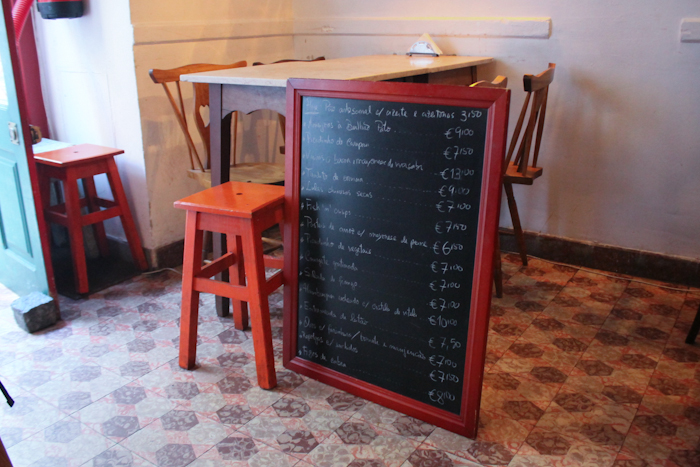
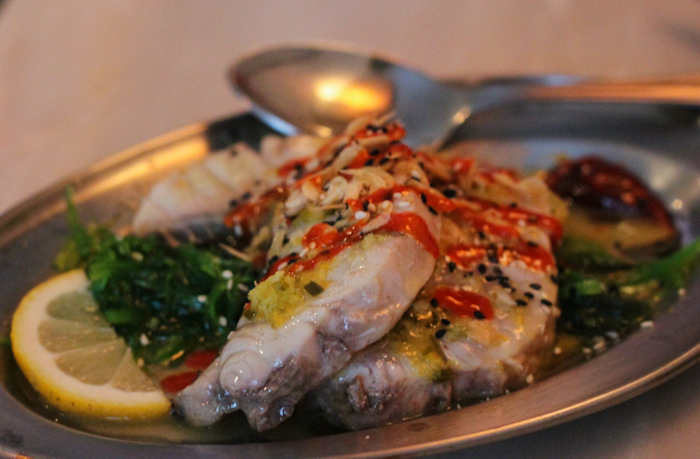
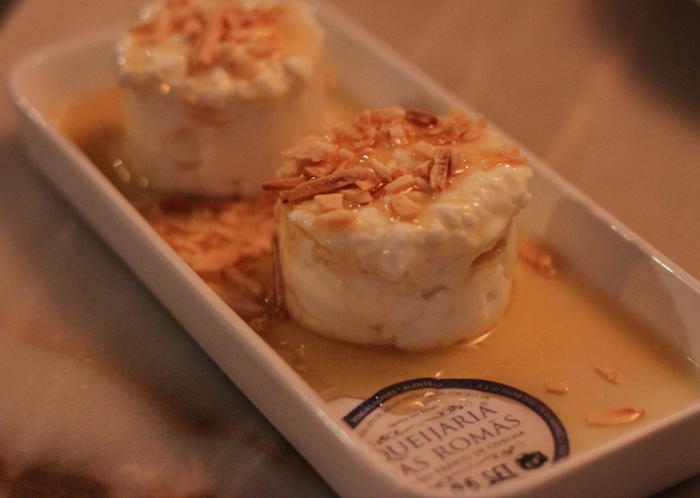
TABERNA DA RUA DAS FLORES (Rua das Flores, 103)
This is my favourite restaurant in all of Lisbon. Favourite. We ate here on our first day. I went back here midweek for their dessert of fresh cheese, honey and almonds. And then, again, we went back there for dinner on our last night in Lisbon because I was worried that no other place might match up, and the pressure of eating well in a city on the last night is always intense. The folks at the restaurant are really nice. Although the menu is written on the chalkboard in Portuguese, they’ll go over everything in English and suggest their recommendations. They have a daily changing menu to keep things exciting. Everything we ate here was superlative, but the one dish I remember so distinctly was the Tiradito de Corvina (fish, a lot like sea bass) barely cooked on hot stones, and raw inside, served on a bed of seaweed, sprinkled with tiny dried prawns and sesame seeds and a dollop of gochujang on the side. And their clams, such good clams with chopped up chourico. I’d say, you can blindly order anything here.
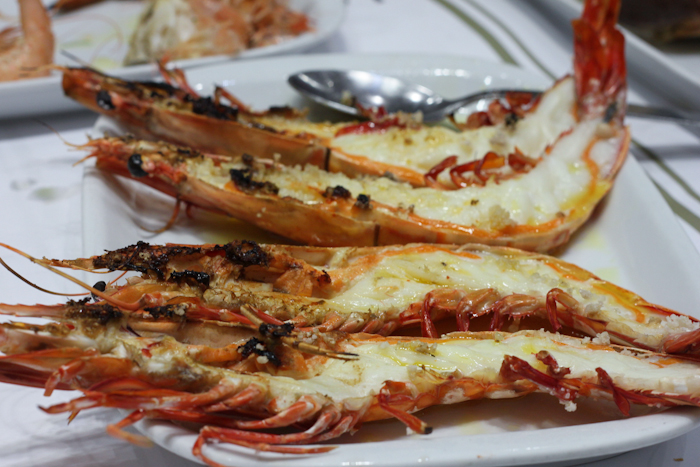

CERVEJARIA RAMIRO (Av. Almirante Reis, 1)
This place is shellfish heaven. Fresh tiger prawns, scarlet prawns, crabs, clams, and goose barnacles for the adventurous. All at affordable prices. And you are expected to finish off with a ‘dessert’ or their famous….steak sandwich! We had eaten way too much, but went back for the steak sandwich the next day. They don’t take reservations so be prepared for a very long queue in the evenings, possibly up to an hour on the weekend.
TABERNA IDEAL (Rua Esperança 112)
Another excellent Taberna, serving food from the islands of Portugal. Good food, average deserts, large portions and excellent atmosphere packed with locals. Especially loved the pairing of deep fried chorico with sliced oranges and their tartine made with honey, rosemary and fresh cheese.
DELICIAS DE GOA (Rua Conde Redondo, 2)
We were curious to try out what Goan food in Lisbon might taste like, given the Portuguese colonisation of Goa in the 16th century. Both the vindaloo and the prawn curry we tried reminded us of food back home.
CASA DA INDIA (Rua Loreto)
Every time we passed by this restaurant, it was always packed, so we popped in for dinner one evening. Simple, inexpensive, no fuss traditional Portuguese food served (despite the name). A tad greasy for me, but Arjun loved their deep fried sausage.
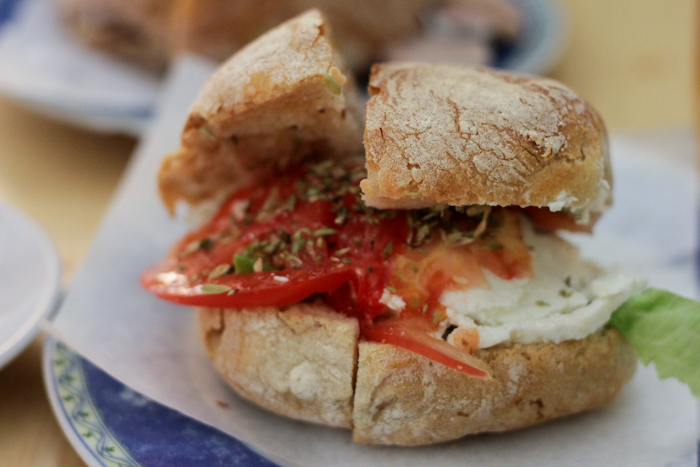
NOVA POMBALINA (Rua do Comércio, 2)
Stop by here for a quick snack of Prego (sandwiches) with a choice of meats – tuna, sucking pig, fresh cheese, fried egg and a few more options on their chalkboard. Wash it down with some fresh fruit juice.
CANTINHO AVILLEZ (Rua Duques de Bragança 7)
Jose Avillez is quite the celebrity in Lisbon, with a string of restaurants attached to his name. We stopped by for lunch at Cantinho Avillez to try out his modern take on Portuguese food. The food was refined and served in cocottes, just like at Christian Constant’s Les Cocottes in Paris. I really liked the strawberry gazpacho with goat cheese here – it reminded me what a fantastic flavour pairing strawberries + tomatoes make.
Some places I wish I’d made it to: Tasca Esquina, Pap Acorda and Salsa e Coentros. We also had some excellent grilled sardines at a tiny restaurant in Alfama – turns out they’re nice and fat around this time of the year (through summer). Must eat that when you can!
Shopping in Lisbon
RUA DOM PEDRO V: This street is dotted with cute boutiques. When you walk further into the bylines of Bairro Alto, you’ll find local designer shops.
Bring Lisbon Home
A VIDA PORTUGUESA
This is the cutest store store in Lisbon. Packed with handicrafts and souvenirs made by Portuguese artists to bring back. We brought back a ceramic swallow, the harbinger of Spring and a poster.
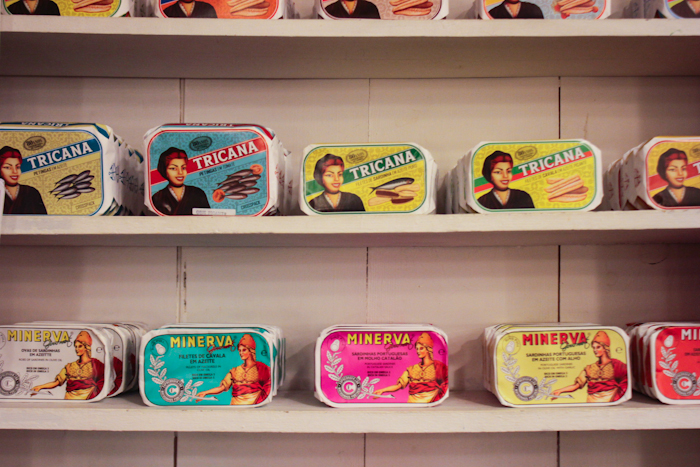
CONSERVEIRA DE LISBOA
Conserveira de Lisboa is the brand under which Portuguese seafood is canned and expired all over the world. Their packaging is what first drew me there.
Day Trips from Lisbon
Every person who had anything to say about Lisbon, insisted we go to Sintra and Cascais while in Lisbon. We acquiesced and weren’t disappointed.
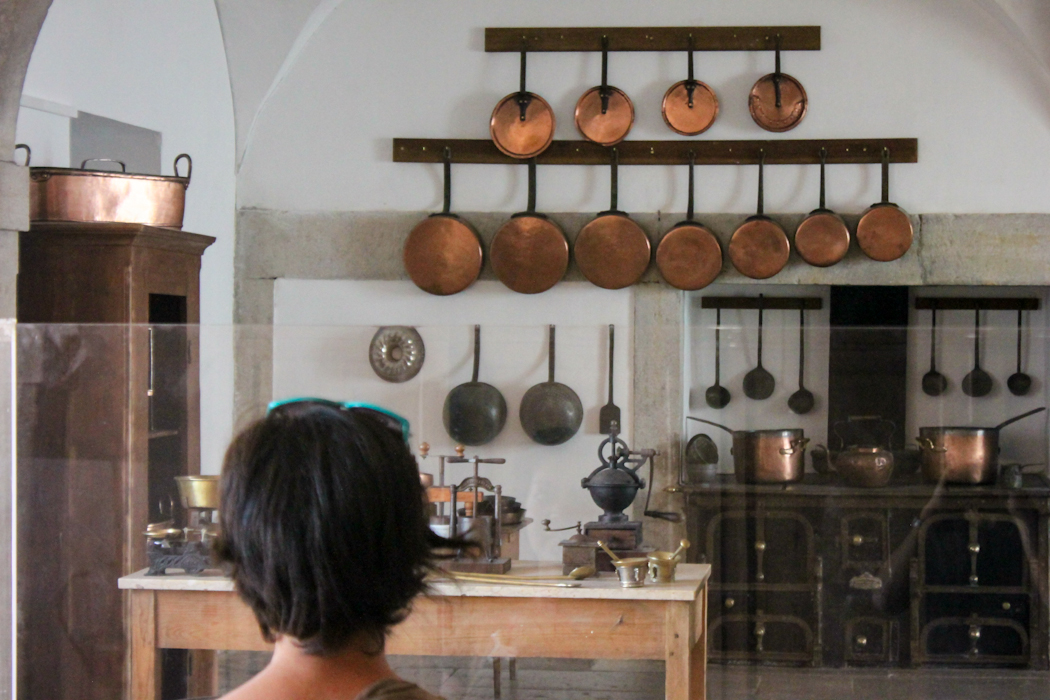
Sintra: The owner of the apartment we stayed at described Sintra as “our jewel”. It’s a gorgeous little town with castles and remains of the past. We visited the Pena Palace and Castle of the Moors, both offering fantastic views of the cityscape. There are a few other spots that might be worth a visit, but these are the major ones. There is a train to Sintra from Lisbon (Rossio) every 20 minutes or so. At Sintra, don’t buy a tourist bus ticket to take you to the sights. Rather, hop onto the public bus (turn right after you step out of the train station) and buy a hop-on-hop-off ticket for €5.
Towards the end of the day, we headed to get some pastries typical to the region:

SAPA (Volta Duche, 12, Sintra)
Close to the train station, Sapa is the place that’s famous for it’s Queijadas, or fresh cheese and coconut filled in a hard, paper thin pastry. Arjun also loved their “Delicias de leite”, their milk custard tart.
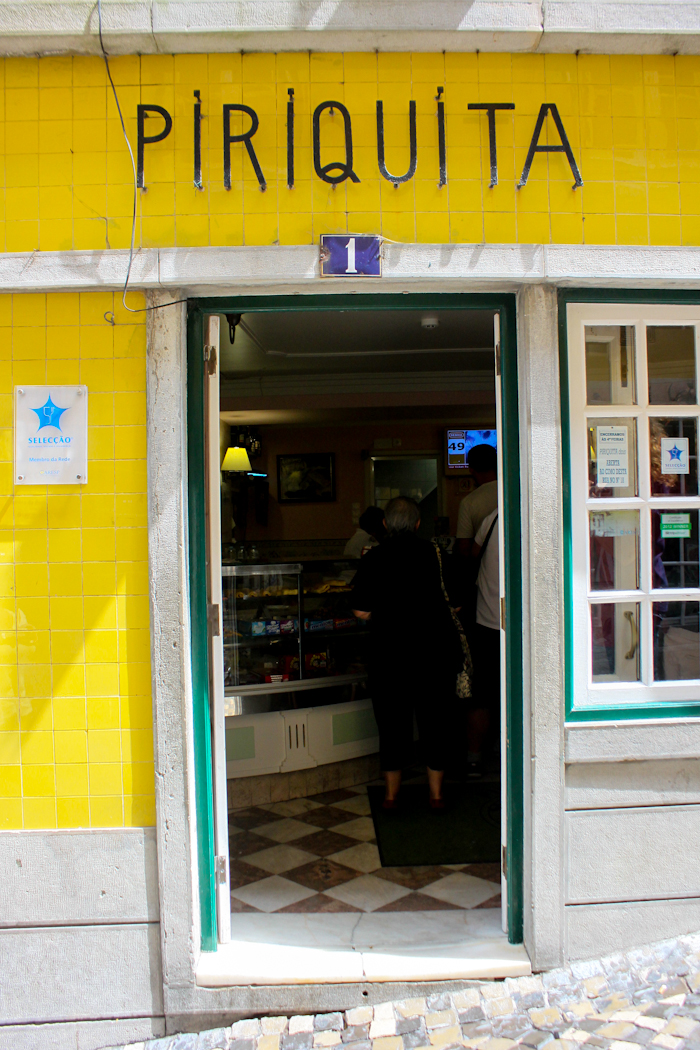
PIRIQUITA (Rua Padarias, 1/7, Sintra)
The other pastry worth seeking out is a “Travesseiro” at Piriquita. Travesseiro literally means ‘pillow’. And this pillow of puff pastry is filled with an eggy almond cream that’s best had with a shot of espresso.
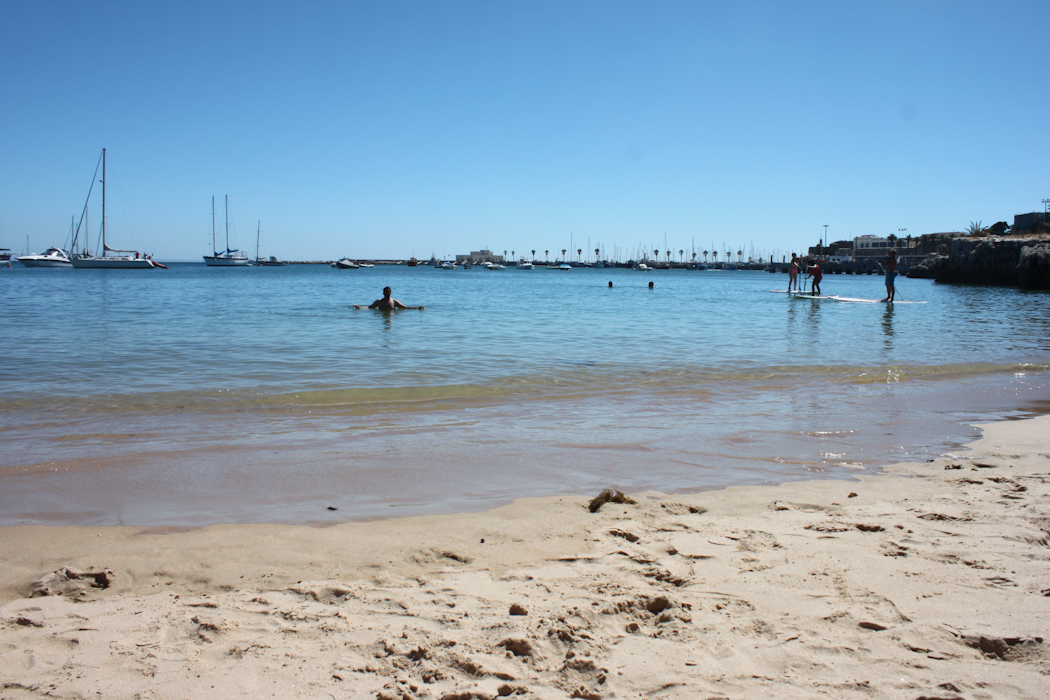
Cascais: Is the place to go for some beach fun, and it’s picturesque to boot with turquoise water and golden sand. The bad part? Even in the peak of summer when the weather is 30C, the water in the Atlantic Ocean is quite cold to swim in. While it’s a tad crowded and the beach right by the train station isn’t very big, I’d suggest hopping out of the train a few stops prior at Estoril (you can see the beaches from the train). There is a train to Cascais from Lisbon (Cais do Sodré train station) every 30 minutes.
Markets in Lisbon
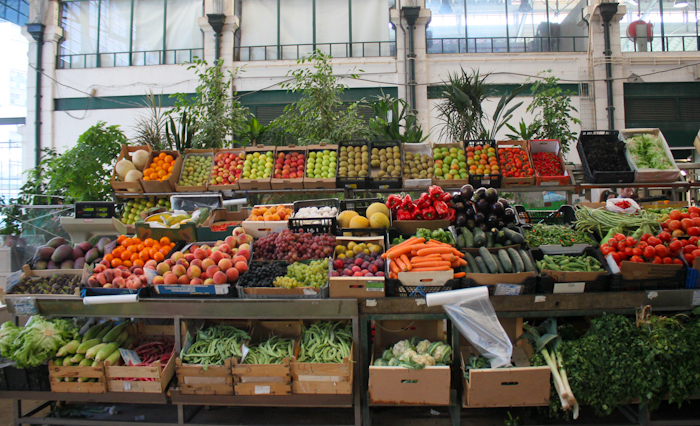
Three good markets: MERCADO DA RIBEIRA (Avenida 24 de Julho), MERCADO 31 DE JANEIRO (Rua Engenheiro Vieira da Silva) and MERCADO DE ALVALADE NORTE (Avenida Rio de Janeiro) are worth visiting. Sergio of Salt of Portugal put me in touch with a friend whom he described as having the “most discriminating palates in Lisbon” who might be able to show me around Mercado da Ribeira. Unfortunately, our schedules didn’t match so I couldn’t meet him, but he did email me his recommendations for the market and how best to manoeuvre the market looking for produce.
Watch
Anthony Bourdain’s Layover episode on Lisbon.
Listen
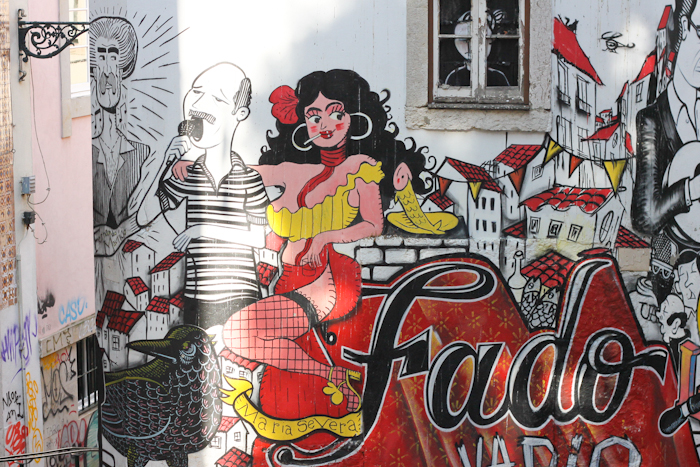
To local Portuguese artists Mariza.